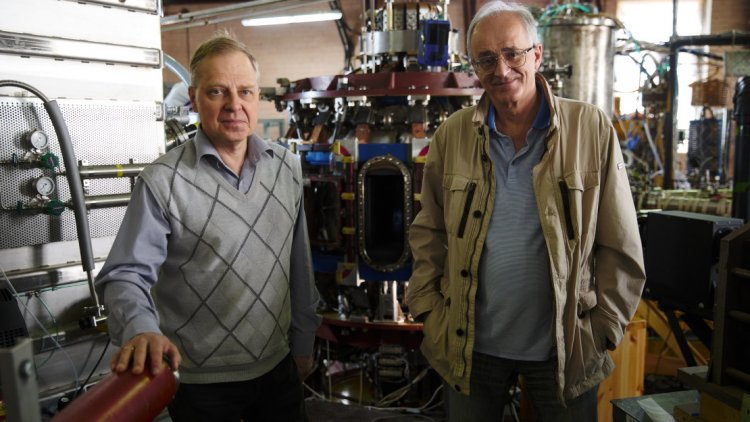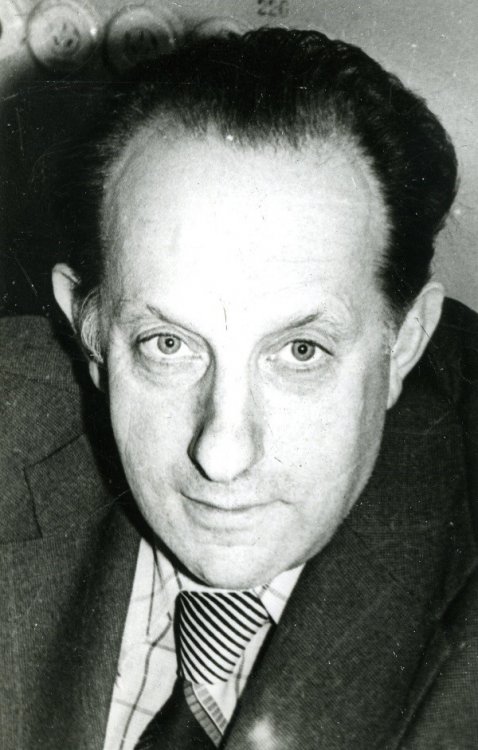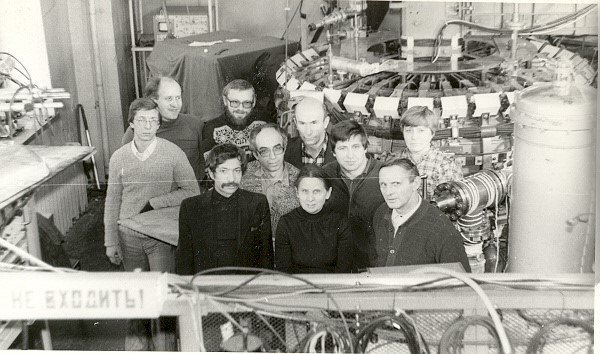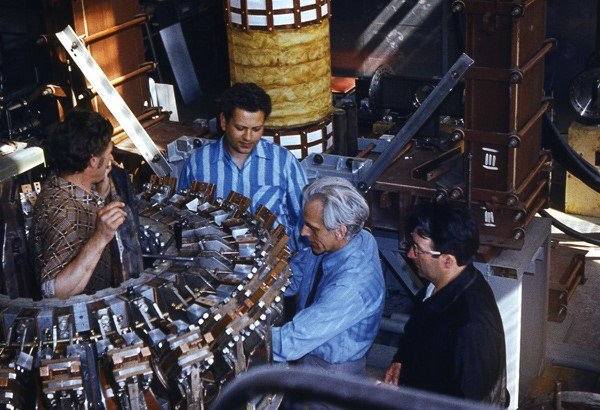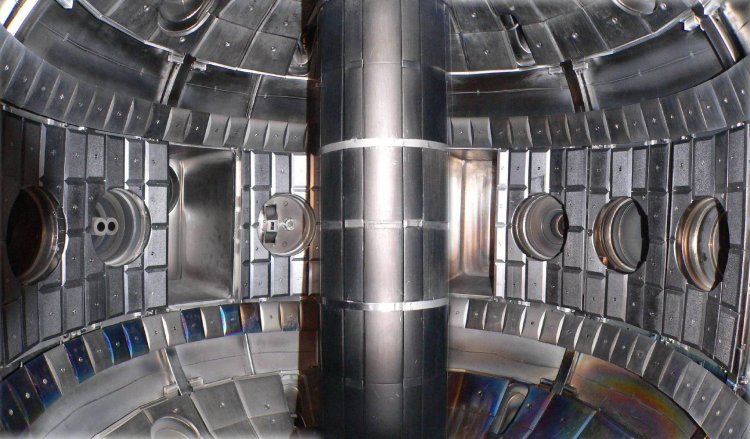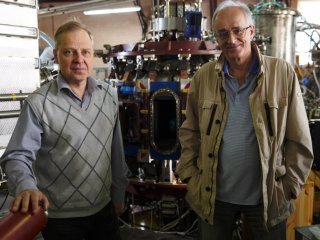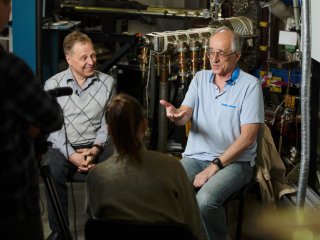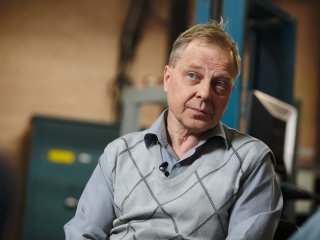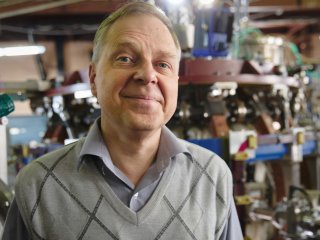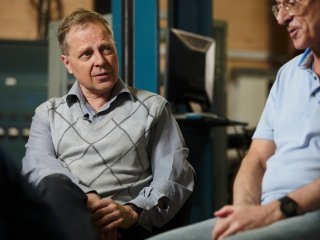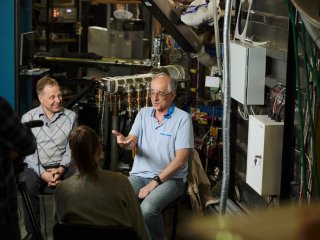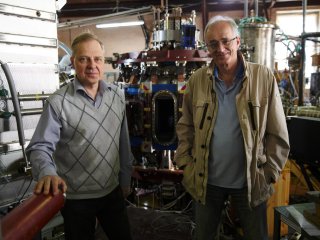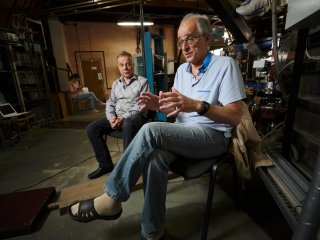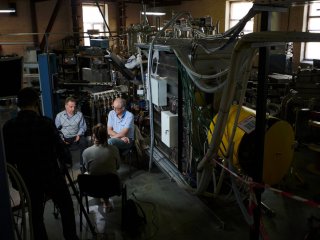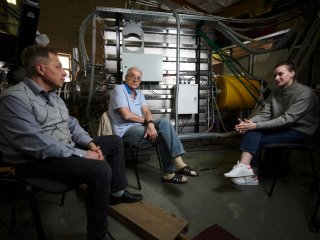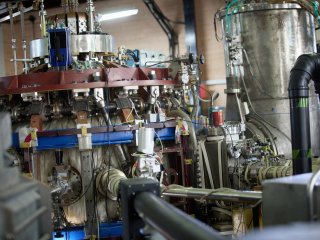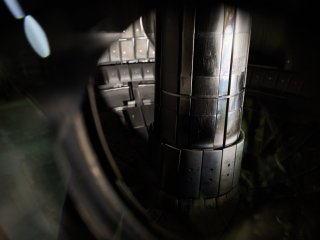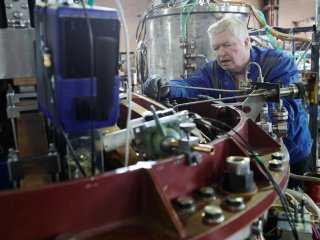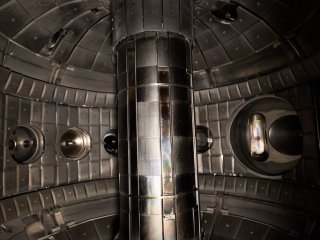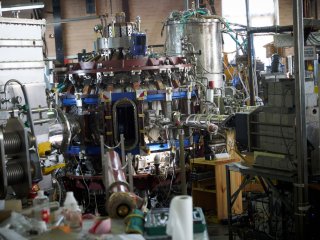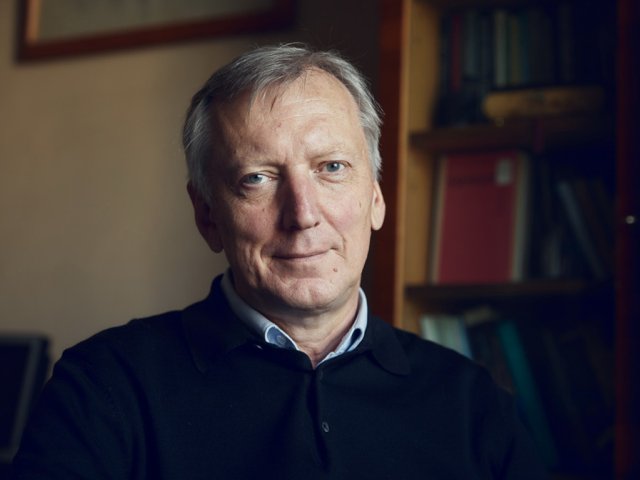Mankind has always strived not only to learn more about nature, but also to use this knowledge for its own benefit. In the 21st century, we set our minds seriously – scientists around the world are aiming for a fundamentally new source of energy based on nuclear reactions similar to those that occur in the core of the Sun. Ambitious? Yes. But that's the way we are. The ITER (International Thermonuclear Experimental Reactor) facility is being built for this purpose. The task of the international project is to prove the possibility of creating a fusion reactor based on the tokamak in practice, as well as to solve the physical and technological problems that may be encountered along the way. The point is, at first glance, such reactions produce much more energy than they consume. Scientists have been working in this direction for more than 60 years, but they have not achieved the desired result yet. It is expected that a tokamak reactor under construction will be able to hold up to 840 cubic meters of glowing hydrogen or plasma and produce at least 500 megawatts of electricity with a consumption of 50 megawatts. How the first tokamaks were created and when to expect the first fusion power plants – an interview with Evgeniy Gusakov and Vladimir Minaev from the Ioffe Institute.
Evgeniy Zinovievich Gusakov – Head of the Laboratory of High-Temperature Plasma Physics at the Ioffe Institute of the Russian Academy of Sciences, Doctor of Physical and Mathematical Sciences, Professor.
Vladimir Borisovich Minaev – Leading Researcher at the Laboratory of High-Temperature Plasma Physics, PhD in Physics and Mathematics, Deputy Head of the Globus-M Spherical Tokamak installation at the Ioffe Institute.
– Why does mankind need a fusion plant?
Gusakov: Perhaps humanity doesn't need the fusion plant itself very much. But we all need energy. It is clear that fossil energy reserves are limited. According to various estimates, oil and gas reserves will only last until the end of the century. Coal is also limited and there are a lot of harmful emissions when it burns. Therefore, the world needs other sources of energy.
Along with conventional nuclear power, thermonuclear fusion offers great opportunities in this regard. Its resource base, in general, is almost unlimited, because it is based on the use of a heavy isotope of hydrogen, called deuterium, which can be isolated from ordinary water. We learned to do it back in the 1940s. In addition, it is necessary to use an even heavier hydrogen isotope – tritium. It is not found in nature, as it is unstable with respect to decay. But it is produced in nuclear power plants and used in thermonuclear experiments, which are now conducted all over the world. It is planned to produce tritium directly in the course of thermonuclear fusion in the future, including in the experimental ITER tokamak reactor, which will start operating in 2025.
Minaev: As GDP grows, so does energy consumption. Thermonuclear fusion can be considered an unlimited source of energy, besides it being very environmentally friendly.
Gusakov: We must not forget that we are talking about man-controlled thermonuclear fusion. After all, there is uncontrolled fusion, and we all exist and live thanks to it. The source of the Sun's energy is thermonuclear fusion. There would be no life without it.
− So, we seek to harness this plasma force of the Sun?
Gusakov: On the Sun, it is harnessed by gravitational forces, and this is a really huge source of energy. On a cosmic scale, the Sun is far enough away from us, yet its energy, in the form of electromagnetic radiation, warms the Earth and makes it possible to have Life on it. We have learned to use this energy directly by converting it into electrical energy.
− How close are we to controlling plasma?
Minaev: The main parameters necessary for the fusion reaction realization have already been obtained at different facilities. Now the task (including that of the ITER project) is to move from purely scientific research to demonstrating the possibility of its practical use. And then create a demonstration reactor. This is quite a long way to go. The ITER facility launch has already been postponed for a total of eight years, from 2017 to 2025, because from an engineering point of view, it is a very complicated plant. And its creation makes it possible to develop new technologies, develop new materials that haven't been used before and find applications for them in other industries.
Gusakov: Most likely, a directly energetically profitable thermonuclear fusion will be carried out in the 30's. Basically, controlled thermonuclear fusion with a small power output has already been performed in the 1990s on two tokamaks – in the United States on the TFTR tokamak and in the UK on the European JET facility, which produced more than ten megawatts of fusion power.
In the ITER case, participants hope to be able to get a controlled thermonuclear combustion, as if the reaction takes place on the Sun. It should be noted that during the first experiments, the plasma was heated with beams of atoms and HF radiation of significantly higher power than was released by thermonuclear fusion reactions. The power of ten to fifteen megawatts was not capable of heating the plasma to “fusion” temperatures. Unlike the first experiments, the ITER plant must operate in a controlled combustion mode, supported by the fusion reaction itself.
In fact, thermonuclear fusion is also a nuclear reaction, so we cannot say that we are talking about exclusively “green” energy. But the main difference between fusion energy and nuclear energy is that we do not need to load nuclear fuel into the reactor for many years, which then decays and produces energy. In the case of a fusion reactor, the fuel is loaded when needed, so the level of radioactivity in the reactor is generally low. In the event of an accident, the release of radioactivity would be very small, unlike the scale of the Chernobyl disaster.
Academician V. E. Golant, the founder of the Plasma Physics Laboratory at the Ioffe Physical-Technical Institute
− Today the term tokamak is used all over the world. When did the idea of its creation arise, and what has been achieved so far?
Minaev: The idea to create a controlled thermonuclear fusion using a tokamak, a magnetic trap with a closed configuration, emerged in Russia in the 1950s. And the first successful experiment, conducted at the Kurchatov Institute on the tokamak T-3, confirmed this scheme workability. And after that, scientists from different countries, including the UK, arrived there. They confirmed that the plasma really heated up quite well. At this point the interest in tokamaks began to surge, and many other facilities in different countries were rebuilt for this configuration.
Today, in addition to the traditional direction using tokamaks, a relatively new direction of compact spherical tokamaks, in which the aspect ratio (ratio of the large torus radius to the small one) is less than two, is developing. In fact, Globus-M and Globus-M2 also belong to this kind of facilities. What are the advantages? First of all, they are compact and therefore affordable. Theory predicts that plasma is more stable in such geometries. Such facilities allow us to obtain plasma with similar and sometimes even superior temperature and density parameters to those of conventional tokamaks. Such compact facilities operate in the United Kingdom, the United States, and Japan.
The experiments allowed us to obtain plasma with parameters close to those of thermonuclear. The scientific community is used to measuring it in kiloelectronvolts, but in simple language it is dozens of millions of degrees. The criterion for reaching the ignition point of a fusion reaction is the fulfillment of the Lawson criterion or reaching a sufficiently large value of the triple product of temperature, plasma density, and energy retention time. As a matter of fact, this very criterion must be fulfilled in the ITER.
Gusakov: In general, the emergence of the fusion tokamak is related to the research and development of thermonuclear weapons. And the first results in both the Soviet Union and the United States were obtained by people who were engaged in the creation of hydrogen bombs. For a long time, the developments of academicians Igor Yevgenyevich Tamm and Andrei Dmitrievich Sakharov remained classified. They put forward the idea of holding plasma particles by a magnetic field in a toroidal configuration trap. The point is that charged particles in the magnetic field move in circles around the force line. They cannot fly freely across the magnetic field line. And if this field line is placed on the toroidal surface, it appears that the particles cannot go far along the magnetic field line either.
After the publication of Tamm's and Sakharov's works, experiments began. However, it turned out that plasma is not trapped, as predicted, and the magnetic field is a sieve and particles and energy slip through it, leaving nothing in the trap volume.
The next significant step was made by experimental physicists from the Kurchatov Institute. Scientists worked with toroidal current-carrying discharges. The problem was that such discharges were very unstable and the plasma kept ejecting onto the walls. Then Soviet physicist Natan Aronovich Yavlinsky suggested reduction of the current that creates and heats the plasma. It turned out that the plasma became much more stable, but it did not become colder. Thus, a stable tokamak discharge was invented. And the first outstanding results were achieved in 1968 on the tokamak T-3 that was built at the I. V. Kurchatov Institute of Atomic Energy under the leadership of academician Lev Andreyevich Artsimovich. At that time, scientists managed to heat plasma to 1 keV (11.6 million °C). The main advantage of tokamak installations is that their current not only heats, but also holds the plasma. After the publication of T-3 results, the British scientists did not believe in the experiment success and arrived in the Soviet Union with their equipment to convince themselves of this device capabilities. And they were convinced.
− How was Globus-M created?
Minaev: The Globus-M spherical tokamak was designed in the very difficult years for our country – the nineties. The late founder of our laboratory, Viktor Yevgenyevich Golant, suggested that we build such a facility and thereby start research in a new promising direction. Prior to that, in the 1970s and 80s, our laboratory developed some methods for heating the tokamak plasma to fusion temperatures using electromagnetic waves (tokamaks FT-1 and FT-2) and adiabatic compression in a growing magnetic field (tokamaks TUMAN). Since the early 1990s, we worked with our American colleagues from Oak Ridge National Laboratory, which provided partial funding, and began to work on the project of a spherical tokamak as well. In 1999, we launched the facility and got the first plasma. The plasma turned out to be stable, high density, and hot enough for such a compact setup.
However, it was necessary to develop additional heating systems for the tokamak in order to consolidate the success. Experts from the Kurchatov and Troitsk Institutes brought an old injector from the T-11 unit, which was not in demand, yet perfectly suited for the Globus. And again, we managed to achieve good results that were recognized by the world community.
On the whole, the facility operated until 2017. During this time, the modernization and creation of a new installation was going on at the same time. The main reason is the relatively weak magnetic field that holds the plasma. When we began to apply methods of additional heating, it turned out that the produced fast particles are poorly retained in the plasma. Therefore, it was decided to modernize the setup and increase the magnetic field.
Gusakov: Moreover, the studies on spherical tokamaks have shown that not only the retention of fast particles, but also the energy retention in this system in general improves with increasing magnetic field. I must say that this is a very specific property of spherical tokamaks. In conventional facilities, confinement is virtually independent of the magnetic field. Energy losses in the tokamak are associated with the plasma’s turbulent movements caused by its instability. I should note that plasma in the tokamak is a very unstable medium, because it is highly non-equilibrium. The walls are very close to it, so the temperature and density are very inhomogeneous. As a result, everything inside the facility is literally boiling. As it turned out, in a spherical tokamak it boils somewhat differently than in a conventional tokamak. It is not entirely clear why this is the case. This is what experimental science is all about. The theory in complex situations cannot always explain everything.
The FT-1 tokamak team at the installation. Team leader – M. M. Larionov, far right in the first row
− So, there are still a lot of fundamental issues to be resolved now?
Gusakov: Right. But nevertheless, the very purpose of getting energy is very practical. We are not talking about the universe properties, the universe structure. We are interested in solving a practical problem, even though it is very complicated.
Thermonuclear fusion has already been done and we know how it happens in the Sun. But in order to control it, we need to solve a lot of very complex physical and engineering problems.
With the ITER construction the latter come to the fore, but a large number of physical problems remain unsolved. The thing is, the issues of complex plasma particle motion, control over it, the problem of changing plasma mixing modes cannot be solved within the framework of simple theoretical models. Often, in order to understand plasma behavior, it is necessary to numerically simulate the motion of a very large number of the individual charged particles in electromagnetic fields created by them.
− So, what challenges do the scientists dealing with this issue face today?
Minaev: If we move from the stage of purely fundamental research to applied research focused on the creation of a power plant, it is necessary to solve a number of fundamental problems. The main of them is the operation in quasi-continuous mode. From the commercial point of view, tokamak, working in pulse mode, is not interesting to anyone. The installation should work, roughly speaking, 200 days a year, so that it would be commercially justified, and the energy economically demanded. So far, the tokamak remains a pulsed installation, where the current in the plasma is excited by a growing magnetic field, which cannot grow indefinitely. Basically, it works as a transformer.
FT-2 tokamak assembly. (From left to right, I. P. Mozharenko, A. N. Levitsky, I. E. Sakharov, and Project Manager V. N. Budnikov)
Gusakov: The Tokamak works on Faraday's law. You have coils that create a holding toroidal magnetic field. And inside, there is an inductor that creates an alternating magnetic field directed along the axis of symmetry of the torus. According to the Faraday's law, an alternating magnetic field creates a quasi-permanent toroidal electric field. In order to keep it constant and the plasma warm, the magnetic flux must change continuously in the inductor. This means that the magnetic field must grow. But, of course, it cannot grow indefinitely, because the currents flowing through the conductors in the inductor from the magnetic field side are subject to increasing forces. It means that the discharge duration in a classical tokamak is limited to a few seconds. And this is not enough for a tokamak reactor.
Minaev: That is why some methods of current maintenance are being developed: high-frequency and injection.
The second problem is related to heating the plasma to a temperature, at which fusion reactions are intense. And the third problem solution requires new approaches in the field of materials science: plasma is heated and somehow its energy gets to the material wall of the facility one way or another. So how it will behave in a prolonged discharge is a big question.
Gusakov: At the moment the question is: would it be possible to work with stainless steel in a fusion reactor? Is it suitable for this purpose? That's why the possibility of switching to another metallurgy – vanadium metallurgy – is now being discussed.
Minaev: Besides, the problem of control is acute. Today we use electromagnetic diagnostics that measure the dynamics of magnetic fluxes, so that we can control and correct the plasma position. During a long discharge, the magnetic flux changes are very small. Therefore, it is not yet completely clear how to control this process under such conditions.
Gusakov: It should be remembered that the spherical tokamak produces neutrons as a result of fusion reactions (or ordinary nuclear reactions), which, in addition to the energy that is produced in fusion reactions, are valuable on their own. Such neutrons can be used in medicine and materials science, as well as to solve the problem of destroying (decontaminating) nuclear waste. In addition, they can also produce fuel for nuclear power, which now accounts for a large amount of energy production. The reserves of uranium-235 isotope used in the nuclear power industry are limited. They can be replenished by using thermonuclear neutrons to irradiate thorium, whose reserves are almost unlimited.
Inside view of the Globus-M tokamak chamber
− Can we say that the projects related to tokamak research in different countries are aimed at ensuring the operation of the ITER as the main facility?
Minaev: No. It's a kind of narrowing of objectives. The ITER is one of the facilities, even though the largest at the moment. Many tokamaks work in support of this project. But the work is not limited to that. There are other fields of scientific interest.
Gusakov: To a large extent, but not completely. It depends on the country very much. In the European Union, for example, the policy is very strict: scientific work must be useful for the ITER project, which is the only way to get funding. In the People's Republic of China, they pay a lot of attention to neutron sources. In the United States, a variety of projects are being developed, only a few of them are aimed at the ITER implementation. At the same time, private investors in the United States support such experiments as well. In other words, the approaches to solving the problem of controlled thermonuclear fusion differ from country to country. However, the ITER is certainly considered to be the flagship of this field.
Minaev: Yes, this is the key international project today.
The Globus-M Spherical Tokamak staff at the facility: (from left to right) A. N. Konovalov, S. Y. Tolstyakov, V. V. Dyachenko, P. B. Shchegolev, M. I. Patrov, E. A. Tukhmeneva, V. K. Gusev (the USF head), V. L. Savitsky, Y. V. Petrov, V. B. Minaev (the USF deputy head), I. V. Miroshnikov, A. Y. Telnova, N. N. Bakharev, A. V. Voronin, E. O. Kiselev, N. A. Khromov, V. I. Varfolomeev, N. V. Sakharov (the USF deputy head), I. M. Balachenkov
− Let's sum it up. When can we get closer to using fusion energy?
Gusakov: The research on controlled thermonuclear fusion is already yielding benefits today. The resulting knowledge about plasma behavior and other fundamental aspects is being used extensively in other fields of physics. So are the technical developments and solutions. As for energy itself, we can recall the words of academician Artsimovich: the reason why this research has been going on for so long is not because it cannot be done faster, but because it is not in demand in the near future. As soon as mankind actually realizes that the energy industry needs fusion reactors, they will appear everywhere in 20 years. Right now, we are discussing the creation of a prototype fusion power plant by 2050.
Minaev: I totally agree. Once mankind has a real need for such energy, it is possible to build a thermonuclear power plant in a fairly short period of time, by investing the necessary funds. It's like a flight into space: a task was set and then, with unlimited funding, it was accomplished in a certain amount of time.
Gusakov: Now we are at a stage where we have not even made a choice in favor of one type of reactor or another. It is not yet clear whether it will be a tokamak or a stellarator. But the choice will be made as soon as the ITER starts working. After that, it will be possible to design prototypes of a fusion power plant. Most likely, the world will see such plants only in the second half of the 21st century.
